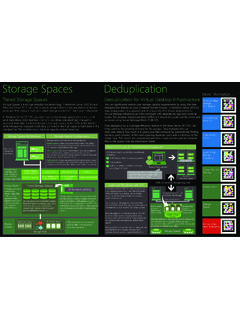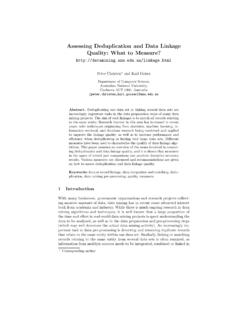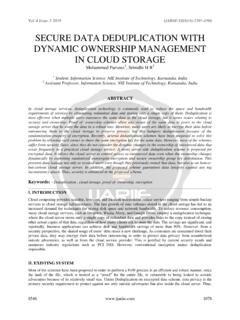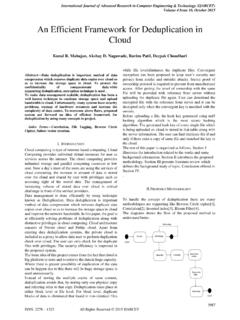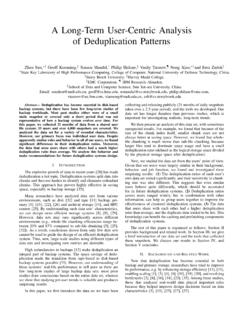Transcription of Understanding data deduplication ratios - SNIA
1 Understanding data deduplication ratios June 2008 Mike Dutch data Management Forum data deduplication & Space Reduction SIG Co-Chair EMC Senior Technologist Understanding data deduplication ratios 2 of 13 2008 STORAGE NETWORKING INDUSTRY ASSOCIATION Table of Contents Optimizing storage The impact on storage Multiple Complementary Space Reduction ratios and Factors that influence space data characteristics and access Operational Space reduction About the About the data Protection About the List of Tables Table 1. Space Reduction ratios and Table 2.
2 data deduplication ratio List of Figures Figure 1. Space Reduction Figure 2. Space Reduction Figure 3. Source data Figure 4. Target data deduplication with Understanding data deduplication ratios 3 of 13 2008 STORAGE NETWORKING INDUSTRY ASSOCIATION Optimizing storage capacity data deduplication and other methods of reducing storage consumption play a vital role in affordably managing today s explosive growth of data . Optimizing the use of storage is part of a broader strategy to provide an efficient information infrastructure that is responsive to dynamic business requirements.
3 This paper will explore the significance of deduplication ratios related to specific capacity optimization techniques within the context of information lifecycle management. The benefits of optimizing storage capacity span cost savings, risk reduction, and process improvement. Capital expenditures on networked storage equipment and floor space can be reduced or deferred. Ongoing operating expenses for power, cooling, and labor can also be reduced because there is less equipment to operate and manage. Increasing the efficiency and effectiveness of their storage environments helps companies remove constraints on data growth, improve their service levels, and better leverage the increasing quantity and variety of data to improve their competitiveness.
4 The impact on storage utilization Capacity optimization refers to any method which reduces the consumption of space required to store a set of data including compression, single instance storage, data deduplication , thin provisioning, copy on write, and pointer remapping. Each of these techniques has a valuable role to play in improving data storage efficiency and may be used in concert to achieve the right balance of resource utilization for specific situations. Before defining each of these terms, it is interesting to note the impact of capacity optimization on storage utilization from two perspectives.
5 The fit more in a bag view ascribes goodness to using an existing storage system to hold more data online longer. The "use a smaller bag" view notes that capacity optimization may provide opportunities to reduce or postpone expenditures. Multiple technologies The terminology used by the press, analysts, and vendors to refer to capacity optimization techniques often serves to obscure an objective evaluation of customer choices. Each term has been used as an umbrella term for one or more space reduction techniques. A practical definition of several terms is provided here to convey the essential similarities and differences of each technique and provide a basis for Understanding the subsequent discussion of space reduction ratios and percentages.
6 Single instance storage (SIS) is the replacement of duplicate files or objects with references to a shared copy. An object is a set of data meaningful to an application such as virtual machine images, virtual tape cartridges, disk volumes, email messages, database records, and object-based storage device objects. Understanding data deduplication ratios 4 of 13 2008 STORAGE NETWORKING INDUSTRY ASSOCIATION data deduplication is the process of examining a data set or byte stream at the sub-file level and storing and/or sending only unique data . There are many different ways to perform this process but the key factor distinguishing data deduplication from SIS is that data is shared at a sub-file level.
7 Compression is the encoding of data to reduce its storage requirement. Lossless data compression methods allow the exact original data to be reconstructed from the compressed data while lossy data compression methods permanently discard some of the original data . Lossless methods are used to compress executable programs and text-based data (such as source code and XML) and where loss of fidelity is not considered acceptable (such as for medical imagery and high definition audio). Example file formats that use lossless data compression include ZIP, GIF, PNG, FLAC, and Dolby TrueHD.
8 Audio and visual information is usually stored in file formats that use lossy compression because superior space savings can be achieved with minor if any loss in perceived quality. Example file formats that use lossy data compression include formats for music (AAC, MP3, Vorbis, WMA), speech (CELP, Speex), images (JPEG), and video ( , Theora, WMV). Copy on write and pointer remapping techniques are used to create changed block point in time copies. Unchanged blocks are shared between the source copy and its snapshots in a manner reminiscent of data deduplication . However, data deduplication has not traditionally been used to refer to the process of sharing common storage between a source copy and its snapshots.
9 Thin provisioning is the transparent allocation of physical storage space for data when it is written ( just in time ) rather than in advance of anticipated consumption. Space savings stems from avoiding media pre-allocation although additional space saving techniques can also be applied. Complementary technologies Capacity optimization technologies can complement each other in two senses. First, they may be used to optimize different infrastructure elements based on their applicability. For example, software with source deduplication capabilities may be used for remote office data protection, storage systems with deduplication capabilities may be used as a backup target for enterprise data center data protection, and compression may be used to reduce the storage requirements for active data .
10 Second, some of the techniques can be used together to achieve additive benefits. For example, compression can be applied to data that has been capacity optimized by other space reduction techniques to gain additional space savings. Note that some technologies require considerable attention when used together. The sequence in which each technology is applied is important. For example, space reduction techniques may achieve little, if any, benefit when applied to data that has previously been compressed or encrypted. However, compression can reduce space consumption when applied to data that has been single-instanced or deduplicated.










